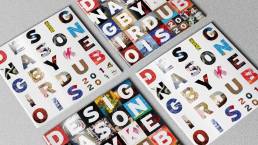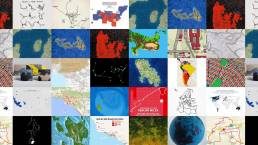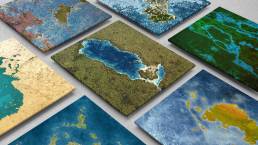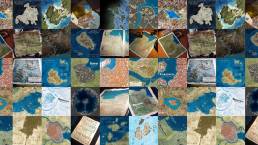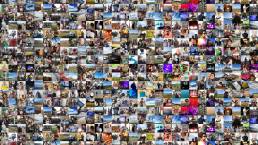
Projects beget projects. Creative people know this, and the best ones take advantage of it—baiting inspiration, recombining old ideas, and building on their own experience and expertise. I know I say this a lot, especially on social media, but thankfully my tendency to repeat myself gets balanced out by my tendency to delete huge swaths of my posting history. This year I frequently mashed together those two impulses, resulting in skimpy Instagram and Twitter feeds populated mostly by montages of boxy, ruthlessly-curated imagery.
Like much of what I’ve felt during this vile Covid era, that mashing was a reaction to my previous decade-plus of laughably performative oversharing. Nobody wants to see that amount of cringe, especially from someone in my demographic. The next-best thing to flat-out deleting every social account (which I actually did for Facebook, Tumblr, and Snapchat) is purging one’s feed and severely curtailing future activity, so that’s what I’m trying to do. I probably won’t be able to sustain that discipline, but for now it’s working. I even learned to love it, by taking a hatchet to all the hashtag-fueled creative challenges that clogged my social feeds from about 2013 until this very month.
Since I haven’t kept up with reviving old blog posts here like I said I would, some history is probably in order. I’ll start with band stuff because, well, I usually do. Circa 2013 my first Instagram series was #30Songs, a mediocre, very Insta-1.0 stab at illustrating 30 of my song lyrics dating back to 1996. I did it in belated parallel to an old blog post series of the same name from a few years prior. It’s since become outdated; between January 2013 and November 2021 I released two solo EPs, so if I did this series now (or maybe updated it?) there would be 44 songs. Regardless, the original series was not very inspired.
However, “30 Songs” got the ol’ brain rolling toward a truly dubious venture I dubbed #Design_A_Song, which ran weekly for a year between April 2014 and May 2015. At the time I was taking on more web development and strategic/project management work at the agencies employing me, which dulled my creativity for design and illustration. However, inspired by friends and colleagues who’d taken on the then-trendy “project of the week” social posts, I gave it a go. The series began well and has some pieces I’m still proud of, but it quickly became a chore and reminded me that I don’t work well doing quantity over quality. I combined them all together in a PDF booklet and called it a day.
Against my better judgment, in 2016 I got inspired to try again with another self-generated hashtag, #50_plus_2, mostly as a counter to what was then considered the most bizarre U.S. presidential election campaign in living memory. When I wasn’t tearing my non-existent hair out over its omnidirectional stupidity, I was trying to make something creative and positive out of 2016’s angst, plus lots of leftover paper samples lying around my house. It worked well and was received well too, so I commemorated the project with a poster and decided that if I had to do hashtag challenges for whatever reason, making my own was much better than following whatever was trending.
Next up was #March_Mapness. I love music artwork and making music artwork, but doing map illustration for 50+2 proved to be much more fun, so for the month of March 2018 I got everybody in on it and made hand-drawn maps by request, then editing with smartphone apps. Doing a challenge like this over a month instead of a year resolved it faster, which appealed to someone like me, who likes to finish things. The outside prompts were mostly helpful and often truly inspired, setting the stage for an eventual major creative breakthrough. Longtime followers probably know where this is going, but setting creative boundaries like “only use smartphone apps” actually fostered a much better ratio of awesome to awful pieces.
So yes, “March Mapness” led directly to “Homeworlds” in April 2019, a series I posted to the #homeworlds_2019 hashtag that prompted flattering “oohs” and “aahs” from family and friends. My ego was soothed during a month where I bailed on volunteering for AIGA and struggled to keep my own small business afloat. I’ve written much more about “Homeworlds” elsewhere, and about how it helped inspire the found-texture fantasy maps that I’m still churning out (more on that later), so that’s enough about that.
At the end of 2019 I joined NACIS and began trying to break into the map illustration space. That culminated in Keirtography, my side-hustle launched in February 2020. Then the pandemic took over, the world ground to a halt, and my business sputtered out. Among many other things I did to keep busy during quarantine was the annual #30DayMapChallenge. It was a nice little lark to follow up the virtual NACIS 2020 cartography conference, but in terms of quality it’s probably my weakest (or next-to-weakest) of all the Instagram challenges I’ve done.
This year I grew weary of the way Instagram warps creative minds. Artists become influencers, getting hung up on follower counts, posting gratuitously trend-chasing content, making too many video reels, and generally hustling in reactive and reductive ways that kill actual creativity. It made me rethink what to do with a series I was posting irregularly to the #foundislands_2020 and #foundislands_2021 hashtags, which rode a “Homeworlds”- and “Game Board”-like wave of inspiration to make found-texture islands and lakes from around town. That “Found Islands” series (which happened whenever I felt like it) had the same ratio of mostly-middling, momentarily-magnificent quality, so I began systematically deleting it after every 5-6 posts, which I then revived as montages to periodically document my work.
I decided against the 30 Day Map Challenge in 2021, but for one last shot at hashtaggery I tried the “Mapvember” tag for fantasy maps. Sadly, it became a chore just like all the others did, but for completeness’ sake I saw it through, and even made a few good pieces. Most of them were quickie posts of recycled images, though, and I found myself stretching the prompts or even disregarding them entirely. That’s no way to get inspired, so the day after the challenge finished, I promptly deleted everything and crammed it all into a one-off montage, just like all the other hashtag challenges.
I do see the appeal of these challenges, but after almost a decade of doing them, I’m over it. I do better work without generalized prompts, or maybe much better work when I choose or stretch or disregard the prompt. Social media is becoming less and less of a helpful place to show off my best originals, let alone superficial fluff or flexes. Starving the beast seems the best way to both protect my originals from copycats or content-scrapers and ditch the lie of “you’re not posting enough, so you must not be relevant!” that social media fosters. However I might be overcorrecting like crazy now, because I got so caught up in the impulse to purge that I did the same to my personal account. I zapped a decade’s worth of posting history—my entire feed—and repackaging the best bits under a truncated, curated, semi-true hashtag called #distorted_decade.
It’s been handy to have my own site and blog to document all this silliness, and even more so when the various social platforms crash for no apparent reason. Maybe it’s just the same as when a web host goes down, but I think it’s important for creative people to not exclusively rely on these platforms to promote their work. No third party company deserves to profit off your creativity, especially one as amoral as Facebook/Instagram. Post your originals, sure, but never leave them up for too long. It cuts down the possibility that they’ll be poached for someone else’s content or clicks, or even appropriated or plagiarized outright. It’s always a good idea to starve this beast of content and work on your own website instead.

